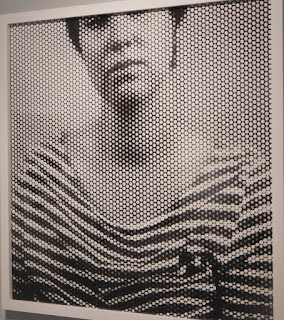 |
| "divide and dissolve #1 and #2" |
 |
| "not there" |
 |
| "the gentle collapsing of every surface" |
 |
| "a momentary impulse" |
 |
| "some may have gotten halfway there, and then changed their minds" |
 |
| "that he might, by force of will" |
our betweened selves
By Tom Wachunas
“Referencing the history of
portraiture-as-social-mirror, I am fascinated with the connection between early
photographic portraits and modern selfies. With the advent of tintypes in the
1860s we entered into a world in which, for the first time, images of the
“self” were widely distributed for mass consumption. Collected, carried and
viewed at any time, tintypes became a method to have a physical connection to
loved ones near and far, and to imagine the lives of famous people by looking
into their faces.” – from the exhibit statement by Greg Martin
EXHIBIT: seen and not
seen, photography by Greg Martin / at Studio M in the Massillon Museum, 121 Lincoln Way, East
(Ohio 172) in downtown Massillon. A visit to the Massillon Museum is always
free. Call the Massillon Museum at
330-833-4061 or visit www.massillonmuseum.org for more information. Exhibit open through December 31 during regular Museum hours,
Tuesday through Saturday, 9:30 a.m. to 5:00 p.m. and Sunday 2:00 to 5:00 p.m.
Somewhere between
reading “…my work speaks to our individually curated and constructed realities
in the digital world,” from Greg Martin’s artist statement, and the fascinating
titles of his photographs, I got lost in thinking about the functions,
instrumentality, and validity of photography as a dependable arbiter or definer
of visible reality. Philosophical questions abound. After all, any photograph is an abstraction, a
reduction, an illusion.
Here, portraiture is only a beginning – a
symbolic jumping off point into the betweened world we’ve made for ourselves. The faces that do appear in
Martin’s pieces aren’t an end unto themselves. They seem rather to hover as
marginal elements within larger, more ambiguous and frangible realms between seeing and knowing, between the
tangible and the tenuous, between intimacy and alienation.
By employing the
highly meticulous wet plate collodion method of making a one-of-a-kind photograph
(a process invented in the 1850s), Martin implies an arresting contrast with
the immediacy of digital image-cloning that saturates today’s social media. And
so it is that his photographs (several of them being mixed-media, 3D
shallow-relief objects, in a way) do exude something of an antique aura. But
that aura is often juxtaposed with modernity via abstract configurations or
superimposed obstructions – multiple transparencies, shadowy layers, or ghostly
planes that can include painted geometric shapes integrated with patterns both
regular and pixilated.
Those abstract components are effectively
metaphorical proxies for digital photo-technology’s capacity to obfuscate the
corporeal world. As if to push the point further, Martin encourages viewers to
engage his pieces from up close and far away with their cell phone cameras –
those indispensable tools for selectively “curating” and miniaturizing complex
dimensionalities into so many compressed imitations.
In the earliest
days of photography, tintype photographs must have surely seemed to be
innocent, even magical totems of connecting with and memorializing the familiar
and yes, the beginnings of commodifying celebrities of the day – “portraiture-as-social-mirror,”
Martin calls it. I’m reminded that photography’s ubiquitous presence in today’s
social mirroring increasingly morphs simple memorializing into elaborate
facades of marketing and advertising.
Troll the internet, meet the memes, wander
the web, cruise the cloud. See all those selves, those faces floating somewhere
between fact and fiction.
No comments:
Post a Comment